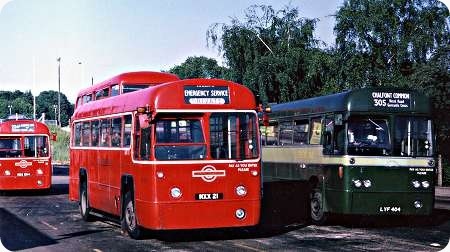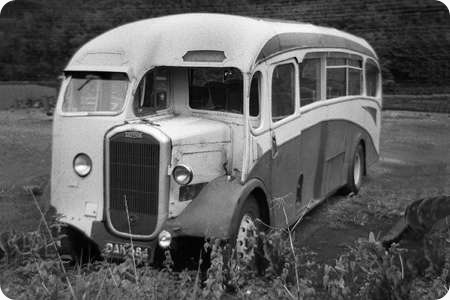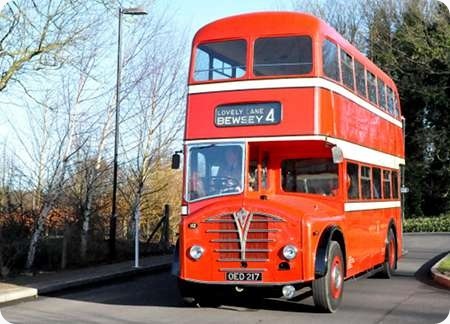
Warrington Corporation
1956
Foden PVD6
East Lancs H30/28R
We don’t see many Foden buses south of Birmingham, and we don’t see many Warrington buses down here either, so here is a view which fits both categories. OED 217 is a Foden PVD6 from 1956, when she was built for Warrington (still in Lancashire at that time!) Corporation. She has an East Lancs H58R body and is seen in the St Catherine’s Park & Ride site in Winchester, on 1 January, 2010, during one of those famous King Alfred Running Days.
Photograph and Copy contributed by Pete Davies
13/10/13 – 08:11
As I said, the day after this was photographed – having ridden on it – a beautiful bus; superbly restored and expertly driven.
David Oldfield
13/10/13 – 14:43
The vehicle looks superb, with very handsome bodywork.
I saw another Warrington Foden PVD6 a couple of weeks ago, parked alongside track, at Onibury level crossing, on the A49, just south of Craven Arms, Salops. Impossible to stop or go back because it is a narrow, busy, road and parking appeared to be difficult. It appears to be fleet No. 102 (MED168) dating from 1954, with a Crossley body, not too dissimilar from the above one, from the brief glimpse I got (wife was driving). It was parked in the open air and looks a bit sad. I hope it won’t go the way of all metal. Incidentally, from a brief visit to Warrington some yeaasrs ago, I seem to recall the destination blind, "NOT IN SERVICE – SORRY! How polite!
Chris Hebbron
13/10/13 – 18:41
David Oldfield’s review of this same New Years Day out in Winchester appears in the "ARTICLES" section on this site!
Pete Davies
14/10/13 – 08:16
I can’t resist a digression here Chris H when you mention Onibury. Do you know Stokesay Court, a wonderful old mansion which lies in glorious grounds. It was taken over as a military hospital in WW1 and my Dad recuperated there from awful injuries on The Somme. The owners by the turn of the century were experiencing financial difficulty in maintaining the place, understandably, until a film company came looking for a stately home for an epic movie and Stokesay Court was chosen – so "Atonement" has to all intents and purposes saved the beautiful old place. Apologies, and now back to Warrington.
Chris Youhill
15/10/13 – 07:18
I went to visit Stokesay, en passant, some months after seeing the slightly flawed ‘Atonement’, but it only took pre-booked tours. We walked around the impressive building and grounds, then moved on. Frustrating, Chris!
A couple of weeks ago, we didn’t have time!
Chris Hebbron
15/10/13 – 11:34
Chris, I was very fortunate indeed as regards Stokesay Court. Among my Dad’s belongings were a couple of sepia postcards of the place – he never actually mentioned it – and it always filled me with curiosity and so, before the "Atonement" period, I decided to take a couple of night’s B & B in the Craven Arms and just look at the place from outside for a bit of "closure." I took the few mementos with me and asked at the local Tourist Office where I was told that the Court was, of course, a private residence with no public access. I briefly told the helpful ladies the reasons for my visit, expecting that would be the end of the matter. "Just a minute" said one, and went to an adjacent room where she could be heard making a phone call, and explaining to whoever was on the other end that "there’s a gentleman ‘ere with documents and postcards etc etc." She returned and I was stunned and delighted to be told "Go straight there now, and Miss Caroline Magnus will talk to you and show you round." Can you imagine my feelings in, I think 2001, to enter the place where seventy odd years before my wounded Dad had recovered from the horrors of the Somme. Miss Magnus (owner of the Court) was most charming and interesting and spent some time with me. She was particularly taken with the khaki military hymn/prayer book – a copy of which was given to each convalescent soldier – which was signed in good old "Swan" blue/black ink by her forbear who was the owner at the time – the inscription reads :-
"Sergeant Youhill, 15 West Yorks. Hoping this will help you and bring you happy memories of Stokesay Court Onibury Shropshire. Margaret Rotton."
The book is one of my most treasured possessions. "15 West Yorks" was of course the "Leeds Pals" who were practically obliterated on the Somme.
With renewed apologies to the good townsfolk of Warrington – now hold very tight please !!
Chris Youhill
16/10/13 – 06:52
Looking at this photo brings it home to me just how much we have lost with the virtual demise of municipal transport. Here we have an operator that bought these vehicles from a small scale manufacturer (at least of buses) no doubt to support local industry with Sandbach being only a stones throw from Warrington. In addition we have a superb livery in what may be termed the ‘traditional’ style, unfettered by advertisements and route branding. We have a clear fleetname with the civic crest on the side panels and a clear and correctly set destination display. I know this is a posed photo in the preservation era but they were really like that in normal service. Warrington had other interesting buses as well with Bristol K6G’s and Leyland PD2 specials with longer but narrower 7’6" wide bodies. Ah nostalgia and civic pride!
Philip Halstead
16/10/13 – 06:52
You definitely deserved red carpet treatment, Chris, and I’m glad it was afforded to you by some very kind folk. No such luck with a great uncle of mine, killed by a sniper on Oct 14th 1914, a couple of weeks after arrival!
And now three rings on the bell!
Chris Hebbron
16/10/13 – 09:42
Philip, as you rightly say this unusual vehicle is quite simply magnificent – the combination of dignified civic pride and good taste with an out of the ordinary mix of chassis and body types. The Fodens were superb vehicles but, for the want of a better expression, needed driving properly. I’d only been driving about two or three weeks when I was asked to run an extra coach on the very popular Sunday evening trips from Otley – price 3/3d per ticket !! I eagerly agreed although I’d no idea at the time where Bishop Monkton was – it involved the treacherous ascent of Norwood Edge – and was allocated MUA 864 similar the 867 below.
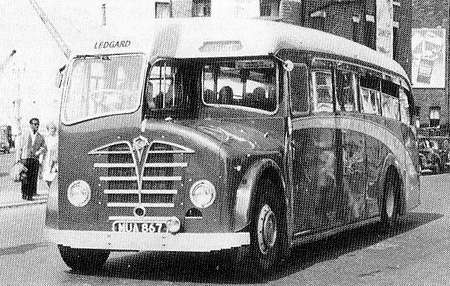
The late turn garage man, a very kindly experienced chap who was a mentor of mine in many ways quietly gasped "’E’s not give thi’ t’Fodden as ‘e??" When I quakingly replied that "he" had poor old Jackie went white and confided "Well, whativver tha’ does – for God’s sake pull up at bottom o’ Norwood Edge and gerrit i’ fust gear – cos if tha dunt and tha tries to change down tha’ll miss it un roll straight back inter t’ ressivoy." Bless dear old Jackie – a kindly saint in overalls. The other driver in the Tiger Cub made sure that I wasn’t left behind, and it was a grand trip which taught me an early lesson with the Fodens – just get the revs wrong by one rpm and the high pitched screeching could be heard for miles around !!
Chris Youhill
16/10/13 – 14:09
Indeed a grand-looking vehicle. Foden’s simple, yet distinctive design for concealing the radiator was surely one of the most attractive of the ‘new look’ fronts then coming into fashion. It just seemed to blend in well with most body styles, whether double-decker, single-decker or coach. (Would I be right in thinking that Foden supplied complete front and bonnet assemblies to the coachbuilders?) Philip, you are so right that the photo brings home much of what has been lost over the years – individuality, civic pride and support for local industry. (Even allowing for inflation, I’m sure fares were also cheaper then too. To travel the one and a half miles from home into Harrogate now costs £2.20 each way. Is that a lot or am I just being a stereotypical Yorkshireman?)
Chris, I loved the story about your Sunday evening excursion up Norwood Edge, as I know it and Lindley Wood ‘ressivoy’ very well. I can vouch for the steepness of the hill, and the sharpness of its bend as you near the top. Hopefully the wonderful views from the summit took your passengers minds off the snail-paced climb in first gear to get there.
Brendan Smith
17/10/13 – 11:40
Brendan – I doubt if the passengers even noticed the view after four or five miles of my woeful attempt to become a polished coach driver on such a "difficult for the unfamiliar" vehicle !! As many of them were no doubt used to seeing me issuing bus tickets as a conductor I fear that they may have been mentally checking their life assurance policies and hoping against hope for a final pint at Bishop Monkton.
Chris Youhill
18/10/13 – 07:56
How I agree with your last point, Chris, the world looks a much better place hurtling to your doom AFTER having a pint or two! Lucky that a chance meeting enabled you all to live another day! I have to say I’ve never seen a single deck version of the PVD, only the rear-engined version. Rather nice looking.
Chris Hebbron
18/10/13 – 17:04
A Plaxton, no less.
David Oldfield
18/10/13 – 17:06
Chris H – there was good news for the reluctant mountaineers after their drinks as the return journey to Otley was by an equally picturesque but less exciting route.
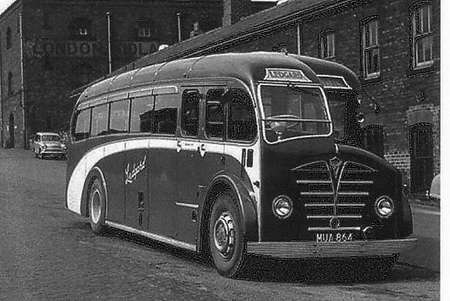
Here is a picture of the actual Foden, MUA 864, while waiting for a peak Summer express duplicate for West Yorkshire RCC – an enormous and highly lucrative contract for Samuel Ledgard. The coach is in the superb original "black roof" livery.
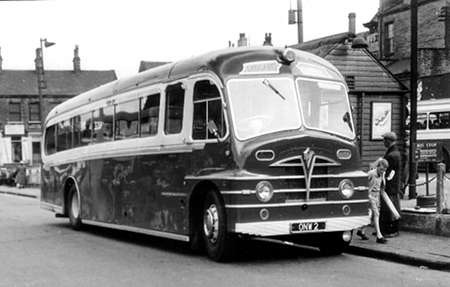
This other picture shows ONW 2 – the two stroke 37 seater of 1951 which had appeared at the Commercial Motor Show as "FWP 1951." It was unchallenged in its heyday as the fastest PSV in the area, and for Winter comfort and ambience sported a two bar electric fire with cheery "coals." It is shown here in Chester Street, Bradford, also on a WYRCC express relief.
Chris Youhill
22/10/13 – 17:34
Fodens south of Birmingham – some ran in South Wales – Caerphilly and West Mon both had single-deckers.
Geoff Kerr
23/10/13 – 05:48
Merthyr bought six double-deckers with unfortunate-looking Welsh Metal Industries bodies.
David Beilby
23/10/13 – 11:47
Here’s an WMI-bodied Foden supplied to Smith’s of Barrhead: www.flickr.com/photos/
Chris Hebbron
23/10/13 – 15:56
Do you think the WMI body is a poor copy of Weymann’s? [Especially the external roof ribs.] Apart from Weymann and Roe, there were some really stylish bodies in the late 40′ and early ’50s – and then there were some real dogs!
David Oldfield
23/10/13 – 15:56
Try www.alangeorge.co.uk/buses.htm for a comprehensive gallery of Merthyr buses. Daimler, Leyland, Bristol and I’m not so sure….. includes these WNI Fodens with their (seemingly) shallow windows, and some newspaper cuttings including the hero driver who saved his passengers on the ice (bet you couldn’t do that in today’s straight-line specials).
Joe
23/10/13 – 15:57
Here’s a Foden of West Mon: //tinyurl.com/nf2ajo7 and here is a Welsh Metal Industries advert of 1948, showing a Merthyr bus.
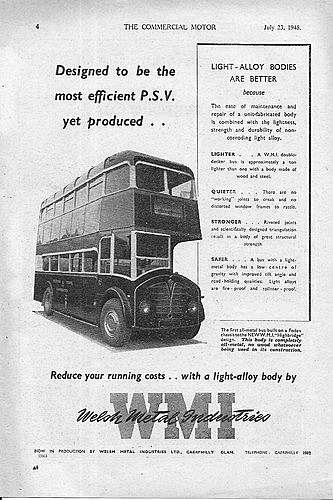
Note the great play being made of their light alloy bodies, primarily sourced from aluminium used from broken up wartime aircraft.
Chris Hebbron
23/10/13 – 16:47
Smiths of Barrhead seemed to favour Fodens. In addition to CGA 235 they had WMI bodied GGD 306 and Massey bodied JYS 466 which, though lowbridge like the WMI bodies, showed a much more sympathetic understanding of the Foden concealed radiator design albeit marred slightly by Massey’s then usual steeply raked top deck profile (see Classic Bus No 112 front cover for an excellent photo).
Orla Nutting
23/10/13 – 17:39
Plaxton, Metalcraft and Whitson seemed to get it right with the coaches and East Lancs (above) probably the best decker.
The Willowbrook that Tracky had from Cawthorne (ex demonstrator) was a bit of a dog, as well. Checking back, it’s not that different from the WMI design. Was this a Foden design used by both concerns?
David Oldfield
24/10/13 – 07:46
Welsh Metal Industries was one of the regional subsidiaries of the Metal Industries Group which also owned Sentinel at this time, and the bodywork was constructed from "stock" MI Group components used by customers such as J C Beadle. If you compare the downstairs windows of the PVD6 in the WMI ad to any shot of a Sentinel-bodied single-decker you will immediately spot the uncanny resemblance. Whitson also used these components (panels and window-pans) on the three SLC6/30 saloons it bodied to Sentinel’s basic design, even though these were timber-framed. The same basic parts had originally been supplied to JC Beadle in the late 1940s for the various semi-integral saloons they built using Bedford, Leyland Cub, and Morris running units.
Neville Mercer
14/02/14 – 07:01
I have driven this Warrington corporation Foden many miles when I lived in England and worked for Warrington corporation transport and seeing this on you site brought back many happy memories. Thanks for posting it
Ken Wilkinson
28/09/14 – 06:43
That Foden is still in the open at Onibury today, together with a sd Foden and at least one other vehicle. All in the open and unprotected.
Tony Martin
28/09/14 – 12:32
Gosh Tony, not often we hear of Onibury (Shropshire) but at Stokesay Court there, which was a military hospital in WW1, my Dad recovered from wounds suffered on the Somme. The mansion has recently appeared in the film "Atonement." What a shame that the Fodens appear to be vulnerable like this.
Chris Youhill
28/09/14 – 18:25
For anyone with deep pockets and a lot of time on their hands, OED 217 is for sale on Ebay for the first £18000 offer. www.ebay.co.uk/itm/TV-Star-1956-Foden-PVD6-East-Lancs-Double-Deck-Bus
Orla Nutting
29/09/14 – 07:40
Sad if a superb, and superbly restored, bus ends up in PSV heaven for the want of a good, and solvent carer. Similarly, as Roger has intimated many times before, there are hoards of RTs and RMs in preservation but very few Fodens. For that reason alone it ought to be saved let alone the other fact, as I have said before, that Fodens were unassailably quality vehicles in their own right.
David Oldfield
02/10/14 – 07:55
This vehicle has been for sale at a totally unrealistic price for several years now. It breaks my heart to see it under threat because the owner (apparently) has the idea that he should recover some of the money he has spent on it in the past. We all know that Bedford OBs fetch fancy prices, but they’re easy to maintain and store (as well as being too cute for words!). Compare the price for the Foden with other similar vehicles in the small ads of B&CP – you could get three fully restored ‘deckers for this amount. Incidentally, does anyone know the current status of the other (Crossley bodied) Warrington Foden which went into preservation?
Neville Mercer
02/10/14 – 11:32
Prices are irrelevant – it’s what people will will pay is the important point. Crosville Motors of WSM have a Lodekka and FLF for sale at £22,500 each. Both in full working order and also can be viewed on Ebay. Of course these are Bristols so obviously more desirable!!!
Ken Jones
03/10/14 – 07:01
NO bias, then, Ken!
Chris Hebbron
05/05/15 – 07:17
I notice some people mentioning about the WBT bus that’s at Onibury on here. I live in Ludlow (we actually moved from Warrington to Ludlow) and it was my dad that actually noticed the WBT buses parked up there. I’ve got a bit of a fear of level crossings (siderodromaphobia) so don’t tend to like crossing there, but I do know if you go from Ludlow end just after the level crossing there is a turning right into Onibury. The A49 is certainly not a place you want to stop to take pictures but if you turn in there, there is plenty of space on Back Lane to park and then walk back round to the level crossing.
I’m quite sure I’ve spotted at least 2 Warrington Borough Transport buses there. I think one of them even has the destination of Wilderspool Causeway on it. Don’t know who owns them or anything about the people living there, but there does seem to be a lot of people living Ludlow who actually moved from Warrington, including Pete Postlethwaite used to live here.
Darren
05/05/15 – 11:54
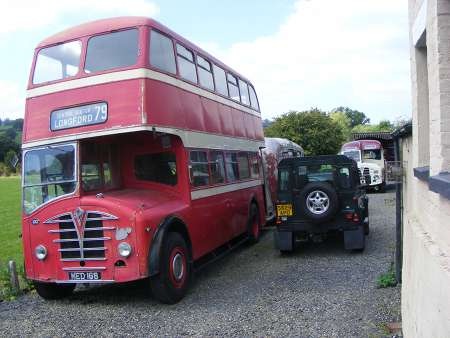
The attached picture of MED 168 was taken in September 2014 – from on the level crossing mentioned by Darren. As can be seen, there were some other vehicles on site – the white Foden coach being KMA 553, but registrations of the others could not be seen from the road.
Peter Delaney
05/05/15 – 11:56
The Foden PSVs were high quality fascinating vehicles. I’m interested in the present location of these two, as when my Dad returned injured from the horrors of The Somme in 1917 he was convalescent at Stokesay Court, Onibury – a mansion which had been given over to military hospital use. I visited the house a few years ago when there were financial difficulties, as with many such gems, but its use in the making of the film "Atonement" has apparently improved its fortunes which is pleasing to hear. Sorry to digress, but for warrington buses to end up there is quite a journey.
Chris Youhill
 Vehicle reminder shot for this posting
Vehicle reminder shot for this posting
03/02/20 – 06:33
The gentleman at Onibury just loves Fodens and when the 1 of only 2 foden double deckers left came up for sale he had to buy it. The single deckers would have been scrapped if he had not saved them and restored them as they were virtually past repair. If you call in as I did when passing he doesn’t mind showing you round, he restores other vehicles as well but rarely rallies them, which is a pity.
Andy Dobson
06/02/20 – 05:50
Steve at Onibury had two half-cab foden coaches and made one good one out of them. Talented engineer.
Roger Burdett
